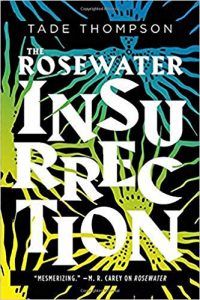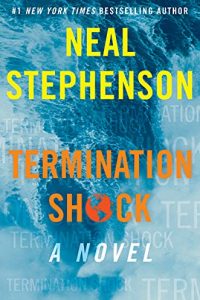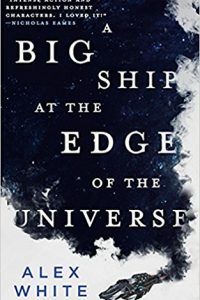Gary K. Wolfe and Ian Mond Review The Rosewater Insurrection by Tade Thompson
 The Rosewater Insurrection, Tade Thompson (Orbit 978-0-316-44908-3, $15.99, 378pp, tp) March 2019.
The Rosewater Insurrection, Tade Thompson (Orbit 978-0-316-44908-3, $15.99, 378pp, tp) March 2019.
Tade Thompson’s wildly original first novel Rosewater, with its political savvy, its problematic main character, its inventive notion of alien contact, and its colorful setting of the improvised city of Rosewater – which grew up around an alien dome near Lagos, Nigeria – also seemed to challenge some readers with its shifting timelines and questions of narrative reliability. Those readers might find The Rosewater Insurrection, the second novel in the Wormwood trilogy, a bit more comfortable, with its more linear chronology – set mostly in the year after the main action of Rosewater – and multiple viewpoints familiar from a whole generation of disaster tales. It’s also more traditional in how it employs familiar SF tropes and visuals. While the aliens seemed remote and enigmatic for most of the first novel, here they act more like traditional body snatchers, no longer coy about their intentions, and we learn about how their Krypton-like dying home planet (they call it Home, and themselves Homians) has sent them house hunting. The hapless “reanimate” zombies, which mostly just wandered about aimlessly in the first novel, can now be organized into attack teams (if you’ve got the right connection to the xenosphere, the atmospheric motes that permit some sensitives to read and manipulate minds). There are giant wormlike things with maws the size of apartment buildings that can erupt like Dune sandworms at convenient or inconvenient times. Scary Rob Bottin tentacles can emerge from a character’s torso and wreak havoc, and one hapless victim of a government experiment explodes in a splatter of brown goo. There are even huge insatiable plants which can absorb people and which are rather pointedly dubbed Beynons as a tribute to John Beynon Harris, who, as John Wyndham, created their triffid ancestors. (It’s not Thompson’s only nod to other writers; he quotes Oscar Wilde and Stephen King, and there’s even a scientist named Bodard.)
Rosewater ended with the main character Kaaro retired from his secret government job and living with his girlfriend Aminat and his dog, waiting out the alien invasion, which he now knows proceeds by gradually taking over one human at a time with “xenoforms.” Kaaro is largely offstage in The Rosewater Insurrection, which is mostly told from four viewpoints. Aminat is now working for the government agency S45, assigned by her glamorous but ice-blooded boss to visit a long-silent space station (keep that in mind for later), but who has to postpone it for a more immediate problem: a woman has been found “with a xenoform count of seventy-nine percent,” and Aminat needs to track her down. That woman (minor spoiler here) turns out to be Alyssa, the second major viewpoint character, whom we first meet as a wife and mother who wakes up with almost total amnesia, not recognizing her family and convinced that she is not really Alyssa. It turns out that she’s also being sought by Anthony, once a homeless London man who has now been completely absorbed by a “footholder” intelligence from inside the dome, who becomes the main spokesman for the alien consciousness known as Wormwood. For a world-conquering, shapeshifting alien predator, though, Anthony is something of a klutz at the details: at one time his underdeveloped avatar is stomped and shot by Aminat, and at another he is skewered by one of those triffid-like Beynons, in a scene that is literally plants vs. zombies. His frustrated supervisor Molara sometimes sounds like she’s dealing with Maxwell Smart.
We meet a few other minor viewpoint characters, such as an assassin who’s been after Kaaro for years, a bigot whose main role is to get eaten by a plant, and a novelist whose long chapter toward the end seems mostly a shorthand way to deliver summary exposition beyond the limits of the other viewpoints. The most important other viewpoint character, though, and the one most responsible for the title The Rosewater Insurrection, is the politically ambitious self-appointed mayor of Rosewater, Jack Jacques, whose unilateral declaration that Rosewood is an independent city-state leads to a war with the Nigerian government that provides the second major plotline. Jack’s a pretty venal character, but his role is crucial in developing the themes of power, corruption, manipulation, and self-invention that seemed so central to the first novel. Those themes may be a bit more subdued here, just as Rosewater‘s portrayal of a decades-long slow burn of an alien invasion here gives way to a shooting war and plenty of CGI-ready grotesqueries, but the pace is faster, the stakes far more immediate, and the characters as vivid as ever. I’d speculated in my review of Rosewater that Thompson might be setting the stage for a radically posthuman world, and he still might be, even though some important new ideas emerge toward the end of The Rosewater Insurrection that might change things entirely. Either way, the final volume of the Wormwood trilogy will be something worth waiting for.
-Gary K. Wolfe
For a bloke who says he doesn’t read trilogies or multi-volume series (see my Year in Review column in last month’s issue of Locus) here I am discussing two in a month. But then, when it comes to Tade Thompson, I don’t have much of a choice. My love affair with his work goes back to 2016, when I reviewed his debut novel, Making Wolf, for Strange Horizons. I described it as a “crime novel hyped up on performance-enhancing drugs sourced either from Quentin Tarantino or Sam Peckinpah.” Later in 2016, Apex published Thompson’s first science fiction novel, Rosewater. While it was more assured than Making Wolf – less pepped up on goofballs – both books shared Thompson’s ear for dialogue and story-telling nous. I was therefore delighted to hear that not only had Rosewater been acquired by Orbit, but that Thompson had been commissioned to write two further books set in Rosewater, comprising the Wormwood trilogy.
The Rosewater Insurrection takes place shortly after the events of Rosewater. The titular city, once a shantytown surrounded by mud and shit, has become a metropolis in miniature as thousands continue to emigrate. They all hope to live near the dome that houses Wormwood, an immense alien that fell to Earth, burrowed underground, and now calls Nigeria home. Once a year a small hole appears in the dome, releasing a microorganism that can cure the incurable and resurrect the dead. However, as we discovered in Rosewater, the organism or “xenoform” does more than heal, it also “mimic[s] human cells”; an alien invasion at the cellular level where the human body is being prepped to accommodate those who sent Wormwood out into space. Section 45, a covert arm of the Nigerian Government led by the enigmatic and ruthless Femi Alaagomeji, is investigating a means of separating human and alien DNA, with messy results. In the meantime, a resident of Rosewater, Alyssa Sutcliffe, wakes up one morning “knowing her name, but not much else.” She is the first human to undergo conversion, her memories wiped and partly replaced by the nascent thoughts of an alien mind. The threat posed by Wormwood, the xenoform, and the newly converted Alyssa Sutcliffe become almost an afterthought when Jack Jacques, the charismatic and ambitious mayor of Rosewater, declares the city’s independence from Nigeria. As you might expect, this doesn’t go down particularly well with the President of Nigeria, who orders the Army to take back Rosewater. Jack Jacques, relying on Wormwood’s protection, is appalled when the dome is breached by some sort of infestation, a weed of alien origin that’s growing out of control in the city.
If I haven’t made it abundantly clear, there’s quite a bit going on in The Rosewater Insurrection. For the sake of clarity, there’s a measure of exposition and info-dumping early in the novel, including a clunky, albeit fascinating section where we’re told Wormwood’s origin story. But as the plot develops, as the action heats up, Thompson’s decision to broaden the novel’s perspective comes into its own. Whereas Rosewater was told exclusively from the viewpoint of Kaaro, a thief, S45 agent, and sensitive whose access to the xenoforms allows him to peek into people’s minds, The Rosewater Insurrection is told, mostly, in the third person. Consequently, the narrative load is spread between a number of characters including the mayor Jack Jacques, Wormwood’s avatar Anthony, and Alyssa Sutcliffe, whose unexpected loss of memory and identity is powerfully realised by Thompson. My favourite character, though, is Aminat Arigbede, Kaaro’s girlfriend, but more importantly an S45 operative and lead researcher into the xenoform. She’s resourceful, courageous, and more than capable of kicking arse and standing up to authority figures like Femi and Jacques. I particularly enjoyed her relationship with Kaaro, one of mutual respect and love.
The highlight of The Rosewater Insurrection, though, is a single chapter, the longest in the book, told from the perspective of Walter Tanmola, a writer, living off the fame of his previous work, who has been asked by Jack Jacques to document the insurrection. Walter’s wry sense of humour, his suspicion of those in authority, his visceral descriptions of the siege, and his unconventional relationship with Jacques’s assistant provide a sense of intimate tragedy that might have been lost if all Thompson had focussed on were the shambling zombies, alien weeds, exploding robots, and furious gun-battles. By the end of the chapter, I found myself close to tears, the human cost of insurrection laid bare. Thompson’s willingness to push himself as a writer, to not just rely on his strengths – the zippy dialogue, the sharp story-telling – is the reason I will continue to follow his career, why I will read whatever he writes.
–Ian Mond
Gary K. Wolfe is Emeritus Professor of Humanities at Roosevelt University and a reviewer for Locus magazine since 1991. His reviews have been collected in Soundings (BSFA Award 2006; Hugo nominee), Bearings (Hugo nominee 2011), and Sightings (2011), and his Evaporating Genres: Essays on Fantastic Literature (Wesleyan) received the Locus Award in 2012. Earlier books include The Known and the Unknown: The Iconography of Science Fiction (Eaton Award, 1981), Harlan Ellison: The Edge of Forever (with Ellen Weil, 2002), and David Lindsay (1982). For the Library of America, he edited American Science Fiction: Nine Classic Novels of the 1950s in 2012, with a similar set for the 1960s forthcoming. He has received the Pilgrim Award from the Science Fiction Research Association, the Distinguished Scholarship Award from the International Association for the Fantastic in the Arts, and a Special World Fantasy Award for criticism. His 24-lecture series How Great Science Fiction Works appeared from The Great Courses in 2016. He has received six Hugo nominations, two for his reviews collections and four for The Coode Street Podcast, which he has co-hosted with Jonathan Strahan for more than 300 episodes. He lives in Chicago.
This review and more like it in the March 2019 issue of Locus.
 While you are here, please take a moment to support Locus with a one-time or recurring donation. We rely on reader donations to keep the magazine and site going, and would like to keep the site paywall free, but WE NEED YOUR FINANCIAL SUPPORT to continue quality coverage of the science fiction and fantasy field.
While you are here, please take a moment to support Locus with a one-time or recurring donation. We rely on reader donations to keep the magazine and site going, and would like to keep the site paywall free, but WE NEED YOUR FINANCIAL SUPPORT to continue quality coverage of the science fiction and fantasy field.







